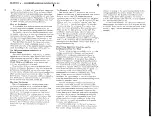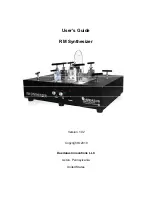
Performance Verification
Publication 31231, Rev. J, October 2003
4-11
4.3.3.3
Amplitude vs. Frequency Correction Factors
The last phase of the Amplitude Calibration sequence determines correction factors as the instrument is
varied across its operating range. These correction factors compensate for RF path losses within the
instrument and following the leveling detector. They also compensate for variations in the leveling
coupler. During this test the instrument is set at a fixed amplitude and the frequency is stepped from the
low to the high limit of the instrument.
4.3.4
Instrument Self Adjustment During Power Up
The following calibration adjustments are made each time the instrument is turned on:
4.3.4.1
YIG Oscillator Coarse Tuning Adjustment
Each time that the instrument is turned on an internal routine determines the setting of the YIG
oscillator tuning DAC. The frequency is first set to 4.5 GHz and the DAC adjusted until the loop locks
and the PLL voltage is approximately zero volts. This process is repeated at 7.5 GHz. Once the DAC
settings for these two points are known, all other set points may be mathematically determined. This
process insures that the coarse tuning for the oscillator is always optimized. It also allows replacement of
the oscillator with no need to manually set up the tracking.
During CW and Step Sweep instrument operation the PLL control voltage is monitored by an ADC. If
the voltage exceeds a narrow window around zero volts, the instrument computer automatically adjusts
the coarse tune DAC in 1-bit steps to maintain the loop voltage within the window. This process occurs
slowly and does not affect the instrument output. Use of this technique eliminates the possibility of
unlock due to temperature variations or other drift causing mechanisms.
4.3.4.2
Tracking Filter Linearity
The tracking filter used in the synthesizer uses a wide range VCO whose tuning sensitivity varies
considerably across its range. To maintain constant loop bandwidth, the loop gain is adjusted
automatically as the frequency is varied.
4.3.4.3
ALC Offset
Another adjustment made each time the instrument is turned on compensates for any offset or zeroing
errors in the amplifiers used for conditioning the detector outputs. Switching in the detector circuits
removes the RF input of each of the detectors. An offset voltage is then summed into the input amplifier
stage and the magnitude adjusted until the ADC output is near zero. This process is repeated for each
gain range and each detector. The values are stored for use during leveling operation. These
measurements are also taken at appropriate times during instrument operation to maintain the accuracy
of the offset adjustment.
Содержание Series 12000A
Страница 3: ...DECLARATION OF CONFORMITY ...
Страница 4: ......
Страница 11: ...Preface Publication 31231 Rev J October 2003 vii ...
Страница 14: ...Series 12000A Microwave Synthesizers x Publication 31231 Rev J October 2003 ...
Страница 18: ...Series 12000A Microwave Synthesizers xiv Publication 31231 Rev J October 2003 ...
Страница 20: ...Series 12000A Microwave Synthesizers xvi Publication 31231 Rev J October 2003 ...
Страница 22: ...Series 12000A Microwave Synthesizers xviii Publication 31231 Rev J October 2003 ...
Страница 24: ...Series 12000A Microwave Synthesizers xx Publication 31231 Rev J October 2003 ...
Страница 62: ...Series 12000A Microwave Synthesizers 1 38 Publication 31231 Rev J October 2003 ...
Страница 234: ...Series 12000A Microwave Synthesizers B 2 Publication 31231 Rev J October 2003 ...
















































